Do you know how to make chats?
In 2013, the company Econsultancy conducted a study that showed that the chat has ceased to be “annoying window that pops up in the corner of the screen.” For buyers, it does not cause rejection. On the contrary, the level of customer satisfaction, communicating with consultants in the chat, was 73%. This figure was much higher than when communicating in more traditional channels - by e-mail (61%) or by phone (44%).
However, the popularity and profitability of chats, like any other channel, depends not so much on technology as such, but on the ability to use it. From the same ingredient can be prepared and a luxurious dish, and something unfit for consumption. At the same time, companies that extend the traditional methods of sales by telephone to chat, of course, save time and effort, but do not take into account the specifics of the chat as an online tool .
Let's take a look at each of the “ingredients” of the chat in order to understand the impact it has on overall success.
')
In the chat you can not hear the intonation and see facial expressions. That is why people sometimes feel that they are not communicating with a real person, but with a car. Moreover, many companies do not oblige operators to install photos. Eventually. the credibility of such a chat is reduced. Imagine that a person does not have a photo, say, in the profile of the VKontakte page - this is alarming, isn't it?
But maybe an even bigger mistake is to install a “stock” photograph of the operator with a headset. This immediately inspires the feeling that the company’s representatives have something to hide, since they hide their faces.
With a photograph, everything is really simple. It should be, it should be personal and should not be too formal. A consultant should not look more important than a site visitor. In this case, of course, it is good if the photo has the ability to communicate with the person. A trivial but surest means for this is a smile.
It’s great if the company has the opportunity to hold a photo session to sustain all the photos of the operators in the same style. Not all employees have images in the archive that are suitable for a reputable company site.


With the name of the operator, the same rule applies as with the photograph: openness above all. If a person sees only the name of the operator, but does not see his last name, then the company has something to hide. And if there is a surname, in which case, the interlocutor argues, one can turn with a complaint against a specific person.
Let's draw an analogy with a business card. Perhaps it is almost impossible to meet a business card in which only the name is written and neither the position nor the name are indicated. This is an element of politeness. In fact, the name is the guarantor of reliability.
As for the post, there is one rule: it is desirable that this post overlaps with the content of the page. Today, many companies prefer to call operators managers. A manager is no longer a cog in the mechanism, but a person with a certain area of responsibility. Contact the manager is quite natural.
In addition, it is desirable to specify the position even more specifically, calling, for example, a department or a direction, even if not in the same way as in a company. For example, it’s great if on a page with a proposal to buy a townhouse in a chat, it’s not just the sales department manager who will respond, but the Townhouses specialist or the low-rise construction department’s answer.
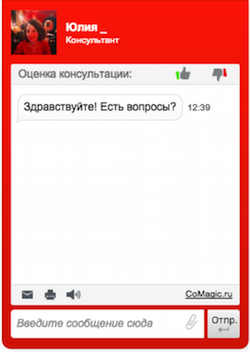
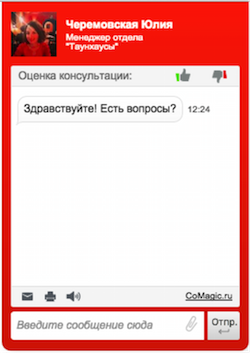
There is an expression: "You will never have a second chance to make a first impression." And this is true for chat rooms. The first message is often called a greeting message, it automatically appears on the page if a person has spent some time on it.
Usually the standard greeting message sounds neutral: “Hello! If you have any questions, ask, I will be happy to help you. ” It sounds polite, but detached. One feels that behind these are soulless algorithms.
It is much better if the greeting message is contextual and somehow coincides with the content of the page. For example, if a person is viewing a section with laptops, you can write something like: “Hello! If you have questions about laptops ... "and further in the text. Here you can say: “By the way, today Lenovo’s laptops have a 10 percent discount,” if you have promotions. So the person will feel concern from the company.


Operators, as they say, on duty, have to communicate with irritated people. The courier was late, the goods turned out to be defective, today it is raining, everything is bad. It is clear that to argue with angry people is unproductive, and more expensive for yourself. It is advisable to listen to the claims, ask what the complainant thinks is the problem, and state the intention to solve it.
Sometimes the operator can decide it himself - for example, say that you can return the defective product tomorrow, and the courier will pick it up specially (of course, if these are the rules in the company). But most often the question must be redirected. In this case, the operator should tell that the question has been forwarded and ask to leave contacts to contact the “victim” when the manager or a competent specialist will answer.
Readiness to help is felt immediately. If the operator sends the user to contracts, contracts, user agreements, the conflict arises out of the blue. But if he enters the position, asks questions about the case, does not interrupt, expresses sympathy, the degree of passion decreases. In a chat, generally speaking, it is easier to listen to a person - and it is not necessary to listen, it is enough to read. On the other hand, feeling at a safe distance, chat visitors can resort to direct threats and insults.
Of course, neither in the chat nor on the phone without a murmur you should not listen to insults. But you should not get off in response objections. They will certainly be taken out of context and picked up by your haters. Patience, tact, consistency, clear wording - all this will make it clear that you are not indifferent to a person, even if he is hundreds or thousands of kilometers away.
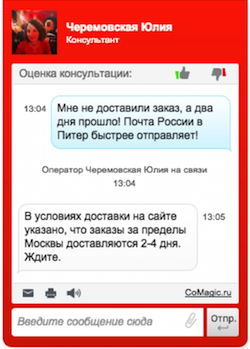
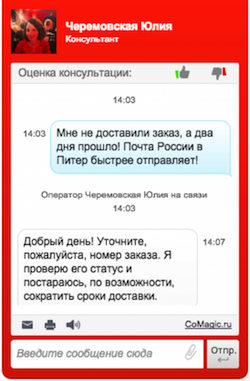
Correctness does not mean boring monotony. Different companies practice a different style of communication with the client. Companies selling youth goods may well use slang. If we are talking about a law firm or a bank, it would seem that there is a need to “fasten all buttons”, but the experience of modern banks (the same Rocketbank) shows that you can be relaxed and joke, even if it comes to banking operations. It all depends on the style of communication with the target audience, which your company professes on the site, in advertising, in social networks.
At the same time, no matter how large the company is, it does not oblige the operator to express with his thoughts misty clericals "in order to improve the quality of service." The language should be simple and clear, partly even spoken. The interlocutor has little time, as a rule, he doesn’t have time to correspond for a long time, therefore the more accurate and unambiguous the answer of the operator, the better. And of course, it is important not to forget about literacy - fortunately, some chats contain a spell checker, and they will not allow “karova” to write, but they are not omnipotent. It is better to answer a little slower, but more intelligent.
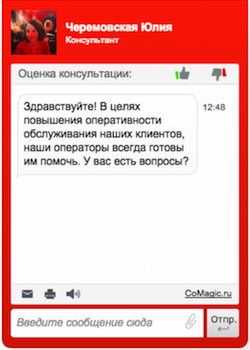
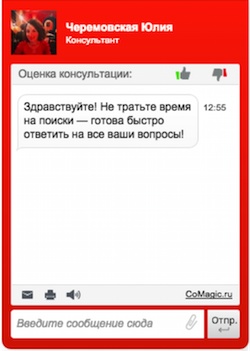
Of these five important chat ingredients, you can make a good “dialogue” that will lead to an order. But, of course, there are many tricks that are learned in practice. For example, if you have many operators, analyze the indicators of the most successful of them. Surely his style of communication can be scaled to others. It is only necessary to find out what is its zest.
In general, since chats are an online tool, analyzing their performance, relying on a bulging navy eye, is not enough. It is necessary to study statistics, improve settings, conduct testing. Only then will your chat become a signature dish that will set the tone for your company's entire sales system.
However, the popularity and profitability of chats, like any other channel, depends not so much on technology as such, but on the ability to use it. From the same ingredient can be prepared and a luxurious dish, and something unfit for consumption. At the same time, companies that extend the traditional methods of sales by telephone to chat, of course, save time and effort, but do not take into account the specifics of the chat as an online tool .
Let's take a look at each of the “ingredients” of the chat in order to understand the impact it has on overall success.
')
Ingredient 1: Photo - Own, 1 pc.
In the chat you can not hear the intonation and see facial expressions. That is why people sometimes feel that they are not communicating with a real person, but with a car. Moreover, many companies do not oblige operators to install photos. Eventually. the credibility of such a chat is reduced. Imagine that a person does not have a photo, say, in the profile of the VKontakte page - this is alarming, isn't it?
But maybe an even bigger mistake is to install a “stock” photograph of the operator with a headset. This immediately inspires the feeling that the company’s representatives have something to hide, since they hide their faces.
With a photograph, everything is really simple. It should be, it should be personal and should not be too formal. A consultant should not look more important than a site visitor. In this case, of course, it is good if the photo has the ability to communicate with the person. A trivial but surest means for this is a smile.
It’s great if the company has the opportunity to hold a photo session to sustain all the photos of the operators in the same style. Not all employees have images in the archive that are suitable for a reputable company site.
Poorly:

Good:

Ingredient 2: name - full, with name and position, 1 pc.
With the name of the operator, the same rule applies as with the photograph: openness above all. If a person sees only the name of the operator, but does not see his last name, then the company has something to hide. And if there is a surname, in which case, the interlocutor argues, one can turn with a complaint against a specific person.
Let's draw an analogy with a business card. Perhaps it is almost impossible to meet a business card in which only the name is written and neither the position nor the name are indicated. This is an element of politeness. In fact, the name is the guarantor of reliability.
As for the post, there is one rule: it is desirable that this post overlaps with the content of the page. Today, many companies prefer to call operators managers. A manager is no longer a cog in the mechanism, but a person with a certain area of responsibility. Contact the manager is quite natural.
In addition, it is desirable to specify the position even more specifically, calling, for example, a department or a direction, even if not in the same way as in a company. For example, it’s great if on a page with a proposal to buy a townhouse in a chat, it’s not just the sales department manager who will respond, but the Townhouses specialist or the low-rise construction department’s answer.
Poorly:

Good:

Ingredient 3: welcome message - contextual, 1 pc. to the page
There is an expression: "You will never have a second chance to make a first impression." And this is true for chat rooms. The first message is often called a greeting message, it automatically appears on the page if a person has spent some time on it.
Usually the standard greeting message sounds neutral: “Hello! If you have any questions, ask, I will be happy to help you. ” It sounds polite, but detached. One feels that behind these are soulless algorithms.
It is much better if the greeting message is contextual and somehow coincides with the content of the page. For example, if a person is viewing a section with laptops, you can write something like: “Hello! If you have questions about laptops ... "and further in the text. Here you can say: “By the way, today Lenovo’s laptops have a 10 percent discount,” if you have promotions. So the person will feel concern from the company.
Poorly:

Good:

Ingredient 4: patience, correctness and willingness to help - the more the better
Operators, as they say, on duty, have to communicate with irritated people. The courier was late, the goods turned out to be defective, today it is raining, everything is bad. It is clear that to argue with angry people is unproductive, and more expensive for yourself. It is advisable to listen to the claims, ask what the complainant thinks is the problem, and state the intention to solve it.
Sometimes the operator can decide it himself - for example, say that you can return the defective product tomorrow, and the courier will pick it up specially (of course, if these are the rules in the company). But most often the question must be redirected. In this case, the operator should tell that the question has been forwarded and ask to leave contacts to contact the “victim” when the manager or a competent specialist will answer.
Readiness to help is felt immediately. If the operator sends the user to contracts, contracts, user agreements, the conflict arises out of the blue. But if he enters the position, asks questions about the case, does not interrupt, expresses sympathy, the degree of passion decreases. In a chat, generally speaking, it is easier to listen to a person - and it is not necessary to listen, it is enough to read. On the other hand, feeling at a safe distance, chat visitors can resort to direct threats and insults.
Of course, neither in the chat nor on the phone without a murmur you should not listen to insults. But you should not get off in response objections. They will certainly be taken out of context and picked up by your haters. Patience, tact, consistency, clear wording - all this will make it clear that you are not indifferent to a person, even if he is hundreds or thousands of kilometers away.
Poorly:

Good:

Ingredient 5: communication format - to taste
Correctness does not mean boring monotony. Different companies practice a different style of communication with the client. Companies selling youth goods may well use slang. If we are talking about a law firm or a bank, it would seem that there is a need to “fasten all buttons”, but the experience of modern banks (the same Rocketbank) shows that you can be relaxed and joke, even if it comes to banking operations. It all depends on the style of communication with the target audience, which your company professes on the site, in advertising, in social networks.
At the same time, no matter how large the company is, it does not oblige the operator to express with his thoughts misty clericals "in order to improve the quality of service." The language should be simple and clear, partly even spoken. The interlocutor has little time, as a rule, he doesn’t have time to correspond for a long time, therefore the more accurate and unambiguous the answer of the operator, the better. And of course, it is important not to forget about literacy - fortunately, some chats contain a spell checker, and they will not allow “karova” to write, but they are not omnipotent. It is better to answer a little slower, but more intelligent.
Poorly:

Good:

===
Of these five important chat ingredients, you can make a good “dialogue” that will lead to an order. But, of course, there are many tricks that are learned in practice. For example, if you have many operators, analyze the indicators of the most successful of them. Surely his style of communication can be scaled to others. It is only necessary to find out what is its zest.
In general, since chats are an online tool, analyzing their performance, relying on a bulging navy eye, is not enough. It is necessary to study statistics, improve settings, conduct testing. Only then will your chat become a signature dish that will set the tone for your company's entire sales system.
Source: https://habr.com/ru/post/293792/
All Articles